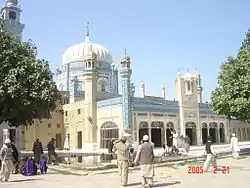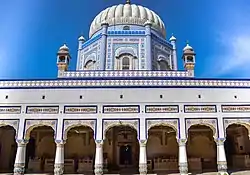Taunsa Sharif
Taunsa (Saraiki,Urdu: تونٚسہ), also called (Taunsa Sharif تونسه شريف), is a city and capital of Taunsa Tehsil of Dera Ghazi Khan District in the Punjab province of Pakistan.[2] The town has important Sufi shrines, the most notable are that of Muhammad Suleman Taunsvi at the Peer Pathan shrine and Sufi Nazar Hussain Buzdar Basti at the Buzdar Shrine.

Taunsa | |
|---|---|
City | |
 Taunsa Sharif | |
 Taunsa Location in Pakistan | |
| Coordinates: 30°42′20″N 70°39′28″E | |
| Country | Pakistan |
| Region | Punjab |
| District | Dera Ghazi Khan |
| Tehsil | Taunsa |
| Towns | 1 |
| Union councils | 13 |
| Elevation | 157 m (515 ft) |
| Population | |
| • Total | 97,100 |
| Time zone | UTC+5 (PST) |
| • Summer (DST) | UTC+6 (PDT) |
| Post code | 32100 |
| Area code(s) | 0642 |
Etymology
Word "taunsa" means thirst as on this location it was very hard to find water in old times so it was given the name Taunsa ( Tass, Thirst). It is customary in Pakistan to use the suffix Sharif with the name of any place where a saint is buried, hence, the city is also called Taunsa Sharif. and its also known by the name of Younan-e-Sagher because of its education. Most of Tehsil Taunsa is led by Baloch and Pathan Feudal Tribes.
Location
Taunsa Sharif is located on the Karachi-Peshawar Highway, which is also known as Indus Highway, it is approximately 975 kilometres (606 mi) from Karachi and 450 kilometres (280 mi) from Lahore. Taunsa is also the location of one of the headworks on the Indus River called Taunsa Barrage, located several kilometres south of Taunsa Sharif city.
Taunsa Barrage
Taunsa is also the location of one of the notable structures on the Indus River called Taunsa Barrage, located several kilometres south of Taunsa city. It was designated a Ramsar site on March 22, 1996. The Taunsa Barrage was completed in 1958, and it has been identified as the barrage with the highest priority for rehabilitation. It requires urgent measures to avoid severe economic and social impacts on the lives of millions of poor farmers through interruption of irrigation on two million acres (8,000 km²) and drinking water in the rural areas of southern Punjab, benefiting several million farmers. In 2003, the World Bank approved a $123 million loan to Pakistan to rehabilitate the Taunsa Barrage on the River Indus whose structure had been damaged owing to soil erosions and old-age. The project was designed to ensure irrigation of the cultivated lands in the area of the Muzaffargarh[3] and Dera Ghazi Khan Tehsil[4] canals, and through the Taunsa-Panjnad Link Canal that supplements the water supply to Panjnad head-works canals.and its also known by the name of younan-e-sager because of its education